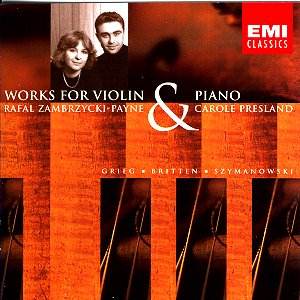As with other releases in the excellent EMI Debut series,
a lot of thought has gone into the programming on this disc. These may
look like a disparate bunch of composers (as indeed they are), but not
only does this make for stimulating (and contrasting) listening, one
is also made aware of differing responses either side of 1900 to the
once popular, intimate medium of violin and piano. We go from the height
of folk-inspired Romanticism, through a more heady exoticism and on
to cleaner, more acerbic textures, though not in this order!
In fact, if one plays the disc straight through, the
Britten Suite is obviously there as a refreshing foil to the
‘meatier’ (and more closely related) pieces. This works well, and though
58 minutes is considered rather short measure these days (various candidates
for a filler came to mind, from all three composers), the quality of
the performances ensures that one does not feel short-changed.
The Szymanowski D Minor Sonata is a relatively
early work, and makes an ideal opening item. The big, rhetorical flourish
that begins the piece gives a good indication of the sort of stylistic
world we are going to encounter. As Jeremy Siepmann’s short but informative
note tells us, the influence of Brahms and Franck is apparent (this
gives it a link to the Grieg); one is also aware of another, more deeply
felt influence, that of Chopin. This is quite obvious in the finale,
and although the Sonata is laid out in a perfectly traditional form,
the odd spicy harmony and hint of mazurka (especially in the little
scherzando episode of the song-like slow movement) show us thumbprints
of a more adventurous composer to come.
The Britten may sound worlds away, but it is
showing us another great composer’s voice emerging from a youthful piece
(Szymanowski was 22, Britten 21). What makes this piece extra interesting
is the hint of Second Viennese procedures. Britten was a lifelong admirer
of Berg, and this Suite was partly composed during a visit to Vienna
in 1934. The most obvious hint is the use of an angular four-note motto
(E-F-B-C) at the very start. This motto is stabbed out piercingly by
the violin, and then proceeds to tie all the material together, the
differing permutations showing that Britten was well aware of the serial
note-row method. That said, there is nothing remotely severe in the
music, which immediately goes off into typically Brittenesque territory
– the short movements are made up of march, lullaby, moto perpetuo and,
most wittily and characteristically, a delicious waltz to finish.
The third, and last of Grieg’s Violin
Sonatas makes a fittingly grand finale to the disc. There is also
the stiffest recorded competition here, with notable versions from Augustin
Dumay (with Maria João Pires) on DG, and the Mordkovich sisters
on Chandos. However, these are groupings of all three sonatas, so are
unlikely to be a real problem for this recital. The Third Sonata
comes from the last decade of Grieg’s life, and is a suitable example
of all that is best about the composer – intense lyricism, tight but
flexible structure and, most of all, a boldness and sweep that have
made it the most popular of the three. Tunes there are a-plenty, but
no hint of sentimentality, especially in the superbly direct, refreshing
performance here. Throughout the disc, Rafal Zambrzycki-Payne displays
a big tone, excellent technique and a probing musicianship, and the
partnering from the experienced Carole Presland is all one could want,
with bravura and subtle understatement in equal measure.
This disc was recorded back in 1997, so one can only
presume contractual reasons for the delayed release. Like many other
Debut discs, it is a real winner, imaginative planning allied to excellent
playing and recording – all at budget price.
Tony Haywood
